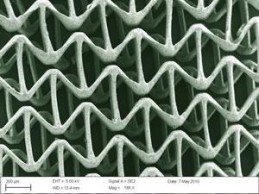New biomaterial closely mimics human tissue
May 27, 2011

Optical image of polyethylene glycol scaffolds expanding in response to stretching (credit: UC San Diego/Shaochen Chen)
A new biomaterial that closely mimics the properties of native human tissue to repair damaged human tissue, such as heart walls, blood vessels, and skin, has been developed by nanoengineers at the University of California, San Diego.
The team created two shapes — “reentrant honeycomb” and “cut missing rib” — using polyethylene glycol scaffolds. Both shapes exhibit the property of negative Poisson’s ratio (that is, not wrinkling when stretched) and maintain this property whether the tissue patch has one or multiple layers.
One layer is double the thickness of a human hair; the number of layers used in a tissue patch depends on the thickness of the native tissue that doctors are trying to repair.
The biofabrication technique uses light, precisely controlled mirrors and a computer projection system — shined on a solution of new cells and polymers — to build three-dimensional scaffolds with well-defined patterns of any shape for tissue engineering.
The manufacturing technology could be used to engineer many other kinds of materials including metal parts used in ships and spacecraft, the nanoengineers said.
Shaochen Chen, et al., Three-Dimensional Polymer Constructs Exhibiting a Tunable Negative Poisson’s Ratio, Advanced Functional Materials, 2011; DOI: 10.1002/adfm.201002022